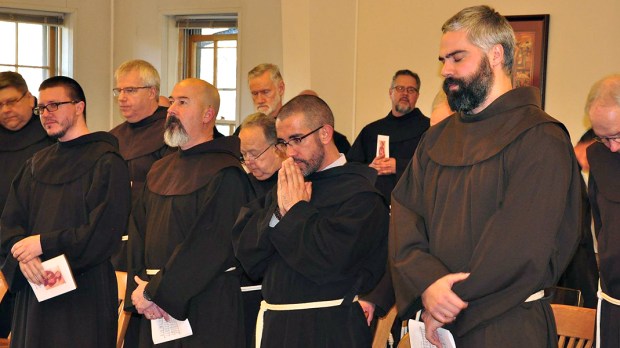In the days after Jesus ascended into heaven, his closest followers gathered together to pray and discern what was next for them. On Pentecost—the 50th day after Easter—the Holy Spirit descended on those first members of the Church inspiring them to leave their locked room and to go out into Jerusalem and, eventually, to travel throughout the world carrying Jesus’ message with them everywhere they went. But this first flurry of missionary activity would be followed by periods of persecution and violence when Christians would be targeted throughout the Roman Empire, giving rise to what has become known as the “Age of the Martyrs.”
Despite the persecution, however, the Church continued to grow and, in 313 the Emperor Constantine legalized the Christian faith. The Church entered new mission fields as Christians were able to emerge from the shadows and publicly profess their faith.
Some, however, felt that the Church—particularly as it became an important political reality—was losing the zeal and simple faith that had sustained generations of Christians. Inspired by the example of hermits who had begun to gather in Palestine and the deserts of Egypt, men and women began to seek God in solitude, embracing a new “white” or “bloodless” martyrdom, sacrificing all that they held dear in order to better serve God.
These early hermits eventually came together, forming communities around holy men and women, including Saint Anthony the Abbot and Saint Macrina “the Younger” and, later Saint Benedict of Nursia. These early monasteries for men and women are the spiritual ancestors of the many religious communities that serve the Church today. And, as we think about the history of religious life, it’s important to remember that religious life was, essentially, a lay movement with very little involvement from deacons, priests, and bishops, who were largely responsible for the work of the Church in cities. The Eucharist was usually only celebrated on Sundays and the lives of these lay monks and nuns focused on praying the Psalms, lectio divina, and on manual labor.
During the Middle Ages—the “Age of the Monasteries”—monastic communities had continued to evolve and the ancient practice of praying the Psalms had developed into the elaborate celebrations of the Divine Office that still form such a vital part of monastic life today. Daily Mass—often offered for the souls of monastery benefactors—had also become common and to help support the ordained monks who spent nearly half their days in prayer, monasteries began to welcome conversii, lay men who served the needs of the monks. Usually from the lower classes and illiterate, the conversii were also skilled artisans and craftsmen and their labor allowed the “choir” monk to focus on prayer. These laborers are the origin of that group of men in the Church that we now call brothers.
In time, these “lay brothers” became the silent workforce of religious communities. And nearly every community had them, working in the fields, sweeping corridors, ringing bells, welcoming guests, making furniture and religious habits, tending livestock, and caring for the sick. It was only in the 17th century that religious leaders like Saint John Baptist de la Salle began to imagine a new form of life for brothers—as educators. The foundation of his Brothers of the Christian Schools marked an important turning point for non-ordained men in the Church. In time, other communities of brothers developed, serving in schools, hospitals, and as missionaries, while others continued to offer their silent labor in support of their communities.
The years since the Second Vatican Council saw a change in the life and ministry of brothers and today in the United States there are nearly 4,100 religious brothers serving in ministries which are as varied as the brothers themselves, many living within mixed communities of priests and brothers. While the day-to-day life of brothers might be very different than what it was prior to the Council, the commitment to compassion, service , and accompaniment of the poor and those in need remains the same.
And yet, the vocation to serve the Church as a brother seems to be largely forgotten. In my own vocational journey, I have often been asked why I want to be “just” a brother or why I don’t go “all the way” to ordination. While we should value the gift of the priesthood, I think it’s important that we also remember the origins of religious life as a lay movement, particularly as we embrace the universal vocation of mission and service—a mission that isn’t only for ordained ministers—that was a part of the renewal of the Second Vatican Council.
As a way to acknowledge the gift that religious brothers are for the Church, a new annual celebration is being observed on May 1—the Memorial of Saint Joseph “the Worker”—simply called Religious Brothers Day.
First proposed by the Brothers Think Tank (an advisory body within the Religious Brothers Conference that addresses issues related to brothers and the vocation to this form of religious life), Religious Brothers Day is a way to recognize the life and ministry of brothers in our communities and parishes.
In anticipation of the celebration, the Apostolic Nuncio to the United States, Archbishop Christophe Pierre, sent greetings from Pope Francis (whose own Jesuit community includes several brothers who are now honored as saints and blesseds): “Conscious of the immense contribution made by generations of brothers to the growth of the Church in the United States through their schools, hospitals and other forms of religious and social outreach, the Holy Father trusts that this day of recognition will confirm them in their distinctive witness of consecrated life and their generous service to God’s Kingdom.” (To read the full text of the message, click here.)
And so, on May 1, as we honor the way that Saint Joseph, a laborer, humbly and quietly cared for Jesus and Mary in their home at Nazareth, take a moment to pray for the Church’s brothers and for their ministries. Pray, too, that God will bless religious communities with many new members who will continue this way of life and service.
To learn more about Religious Brothers Day, visit: http://www.yearforconsecratedlife.com/
A prayer for Religious Brothers Day +
God of mercy and compassion, thank you for the extraordinary life, witness, and ministry of Religious Brothers in our Church. In your wisdom, you have called these ordinary men to generously serve, pray, and share your healing love with others.As we celebrate Religious Brothers Day, deepen our appreciation for the vocation of Religious Brothers, their congregational charisms, and their commitment to vowed community life.Strengthened by our baptismal call to holiness, inspire us to invite men to consider religious life as a Religious Brother.Grant all Religious Brothers the grace and perseverance they need to proclaim your Holy Word for the life of our Church and our world. Amen. (Adapted from a prayer composed by the Brothers Think Tank)

Read more:
She’s a Tertiary? He’s an Oblate? What Is That About?

